After one week in Galapagos, and with amazing memories from the central part of the archipelago, it was time to set sail toward Genovesa Island. This Island is located above the equatorial line and away from any other Island. Despite the distance from other Islands, this is the home for a couple of hundred thousand sea birds and land birds.
This Island has special adaptations compared with the rest of the archipelago. For example the prickly pear cactus, in this place, is very soft because, they have no natural predator on the Island such as land iguanas or giant tortoises. This island also has marine iguanas with one of the smallest body sizes because the water is a bit warmer compared to rest of the archipelago and this influences the growth of algae, which is the main food for these marine reptiles.
Genovesa also lacks the presence of the top predator in the archipelago, the Galapagos hawk. That is the reason why on this Island the short-eared owl is the top of the food chain. What is even more impressive is that this fact allows the owl to hunt in the daylight. It’s quite an impressive sight.
This Island has a huge caldera, with its front part collapsed a long, long time ago. It was amazing when the National Geographic islander entered the caldera. We received a welcoming committee of Nazca boobies, red footed boobies, frigates, red-billed tropic birds, and swallow-tailed gulls. Along the cliffs Galapagos sea lions greeted us as well.
It was a magic week in this enchanted archipelago.









